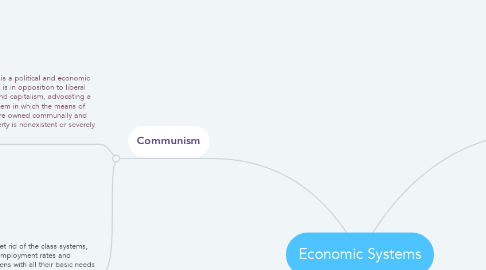
1. Communism
1.1. Communism is a political and economic idealogy that is in opposition to liberal democracy and capitalism, advocating a classless system in which the means of production are owned communally and private property is nonexistent or severely lessened
1.1.1. There are several places in which all the property was/is public and the government owns and controls the manufacturing and transportation industries. Examples: Chine - in 1949 it became a communist country and was ruled by the communist party of china. Cuba- Fidel Castro took over the government in 1959 and it became completely communistic by 1961, ruled by the Communist Party of Cuba. North Korea, Laos, Vietnam are additional examples.
1.2. Pros: It can get rid of the class systems, decrease unemployment rates and provides citizens with all their basic needs
1.2.1. Cons: Can also lead to lack of motivation/ambition, can fuel poverty by creating an unemployment problem, constrains the voice of the people and you could see corruption just like with capitalism
2. UNITED STATES OF AMERICA'S ECONOMIC SYSTEM
2.1. The United States has a mixed economic system. Mostly socialism and capitalism are prevalent. The government controls certain things such as education, the justice system, hospital care and postal service. People are free to create private businesses but they must be registered with government agencies and require certain licenses. If you wanted to sell a product that may result in negative side effects you may be subject to heavy taxation to discourage its use. The government cannot shut down companies forcefully without a fair trial. Also, the market determines what the price of goods and services will be.
3. THE IMPORTANCE OF AN ECONOMIC SYSTEM
3.1. It is important for societies to have some sort of economic system in place because it creates balance and provides structure. In order for us to live properly, our environments must be stable. Having a system in place ensures survival, as the basic human needs include shelter food, and other necessities. In order for humans not to revert back to our savage like ways, we must have a sustainable operating system. It is necessary for humans to positively evolve.
4. Capitalism
4.1. Capitalism is an economic system in which capital goods are owned by private individuals or businesses. The production of the goods and services is based on supply and demand i n the market economy rather than through a planned or command economy. The true definition or purest form of capitalism would be laissez-faire which is when private individuals are completely unrestrained in determining where to invest, what to produce or sell and at which prices to exchange goods or services, without controls.
4.1.1. Examples of capitalistic systems in societies could include Vietnam, Bangladesh, South Korea, China, Ghana...there are more. Although most places are not 100% these places reflect it more than others. Bangladesh is one of the poorest countries in South Asia and the world but they believe that capitalism and free markets is what will drive them to prosperity. They believe that open trade creates jobs and leads to better wages. They realize it will not happen overnight but that favoring new jobs and new investment will ultimately raise them out of poverty and create better conditions in their countries.
4.2. Pros: The incentive to be rich or wealthy encourages innovation, consumers are free to choose the products they desire and economic freedom helps political freedom.
4.2.1. Cons: Social benefits end up being ignored. A profit maximizing capitalist firm is likely to ignore negative externalities such as pollution from production which can harm living standards. There is inherited wealth and wealth inequaluty
5. Socialism
5.1. Socialism is a system based on the public ownership (collective/common ownership) of the means of production. This includes the machinery, tools and factories used to produce goods that aim to directly satisfy human needs. In a purely socialist system, all legal production and distribution decisions are made by the government and individuals rely on the state for everything from food to healthcare. The government determines output and what the price is for these goods and services.
5.1.1. An example of a socialist system include Canada's welfare system which is extensive. They have free health/medical care. Finland has one of the world's best education systems, with no tuition fees and they also provide free meals for their students. The literacy rate in Finland is an astounding 100 percent. Equality is considered one of the most important values also like Denmark.
5.1.2. Pros: Every citizen will have access to education and health care, there will be no classes and corporations will no longer have a monopoly on certain industries.
5.1.2.1. Cons: It gives the government much if not full control, demands higher taxes and can result in a lack of motivation since the goal is to make people's lives more comfortable

